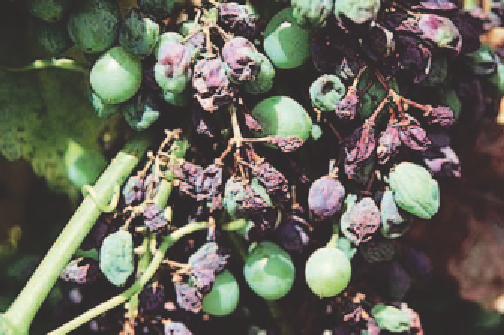Agriculture Reference
In-Depth Information
Oilspots and/or damage to bunches will appear after an
incubation period of 5-17 days, depending on
temperature. Secondary infection (the movement of the
pathogen from leaf to leaf, or leaf to bunches) can then
spread the disease rapidly during warm, humid nights.
Te mp e r at u re s of 13
C or more are required, during
periods when humidity reaches more than 98% for at least
four hours at night, for spores to be produced on the
undersides of oilspots and carried by wind and water
splash to adjacent foliage. If the leaves remain wet for two
hours or more in the morning, the spores will germinate
to cause new infections. Secondary spread can be
extremely rapid and highly destructive under favourable
conditions. Outbreaks often begin in more humid,
sheltered or low-lying areas of the vineyard.
°
Fig 9.16 White down (downy mildew spores) may develop on
bunches under suitable conditions (left). Downy mildew damage
to bunch (right).
Importance
Downy mildew is a major disease in almost all grape-
production regions where warm, wet weather occurs
during spring and summer. Extensive crop loss can occur
where control is inadequate.
Management
•
Monitor crops closely, particularly in spring and when
weather favourable for disease development is predicted.
Apply recommended pre-infection (protectant) and/
or post-infection (eradicant) fungicides as indicated by
monitoring weather conditions and the growth stage
of the vines. Pre-infection sprays need to be applied
as close as possible
before
an infection period, while
post-infection fungicides are best applied as soon as
possible (within fi ve days)
after
an infection event. Some
automatic weather stations provide an infection alert
and can be used to help time sprays appropriately while
CropWatch Online (www.cropwatch.com.au) provides
guidance on the optimum timing of sprays for some
regions of Australia.
•
Fig 9.17 Bunches infected with downy mildew soon after flowering
develop a purple hue, shrivel and fall.
Young bunches at or near f flowering are very susceptible
and are rapidly killed if infected. They then appear brown
and oily and may be covered by a white downy growth.
Source of infection and spread
The pathogen survives as resistant oospores in old, infected
leaf residues in the soil. Oospores may survive for many
seasons until favourable conditions allow them to
germinate and produce swimming spores (zoospores),
which are splash-dispersed to the foliage. The movement
of the pathogen from the soil to the vine is called primary
infection and requires conditions summarised by the rule
of thumb 10:10:24. That is, at least 10 mm rainfall is
needed at temperatures of at least 10
BOTRYTIS BUNCH ROT AND BLIGHT
■
Cause
The fungus
Botrytis cinerea
.
Symptoms
Young leaves, bunches and shoots recently damaged by
insects, wind, hail or rain-splitting are more likely to
develop Botrytis infection.
C during a 24-hour
period. More particularly, the soil must be wet for at least
16 hours for the oospores to germinate and release the
zoospores, which then need to be splashed to the
undersides of leaves. Primary infection will be completed
if the foliage remains wet for two or more hours.
°
On leaves, V-shaped areas of dead, brown tissue often with
a broad, yellow margin extend from the edge of the leaf
into the main veins.













